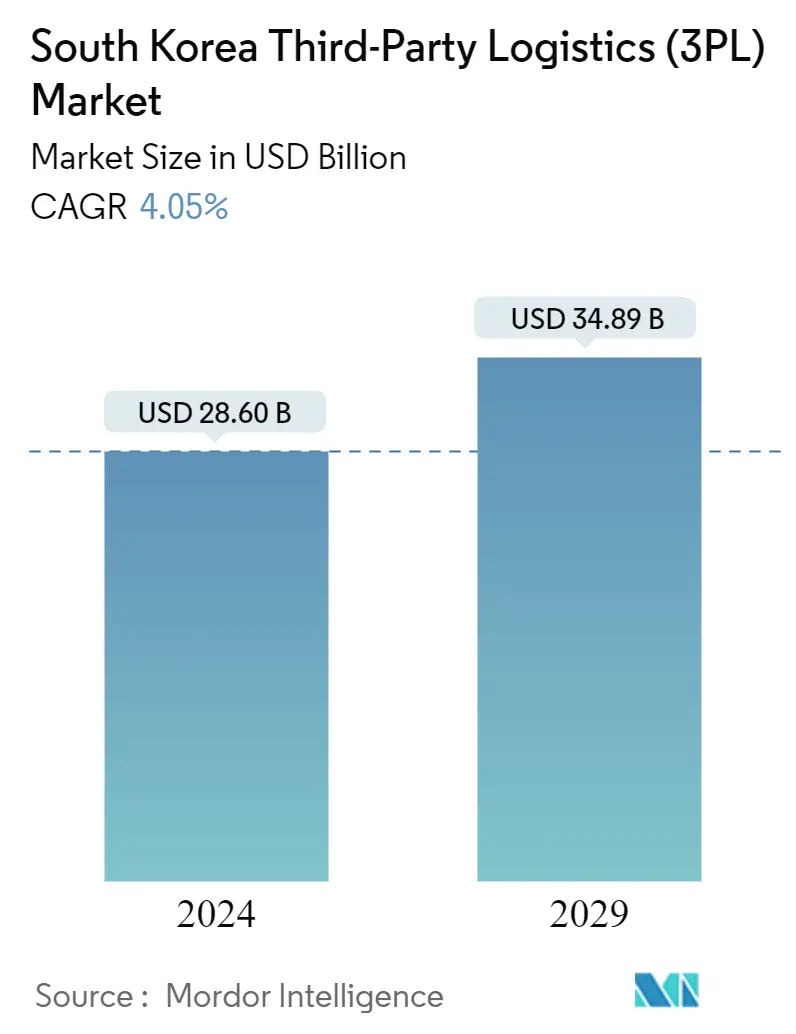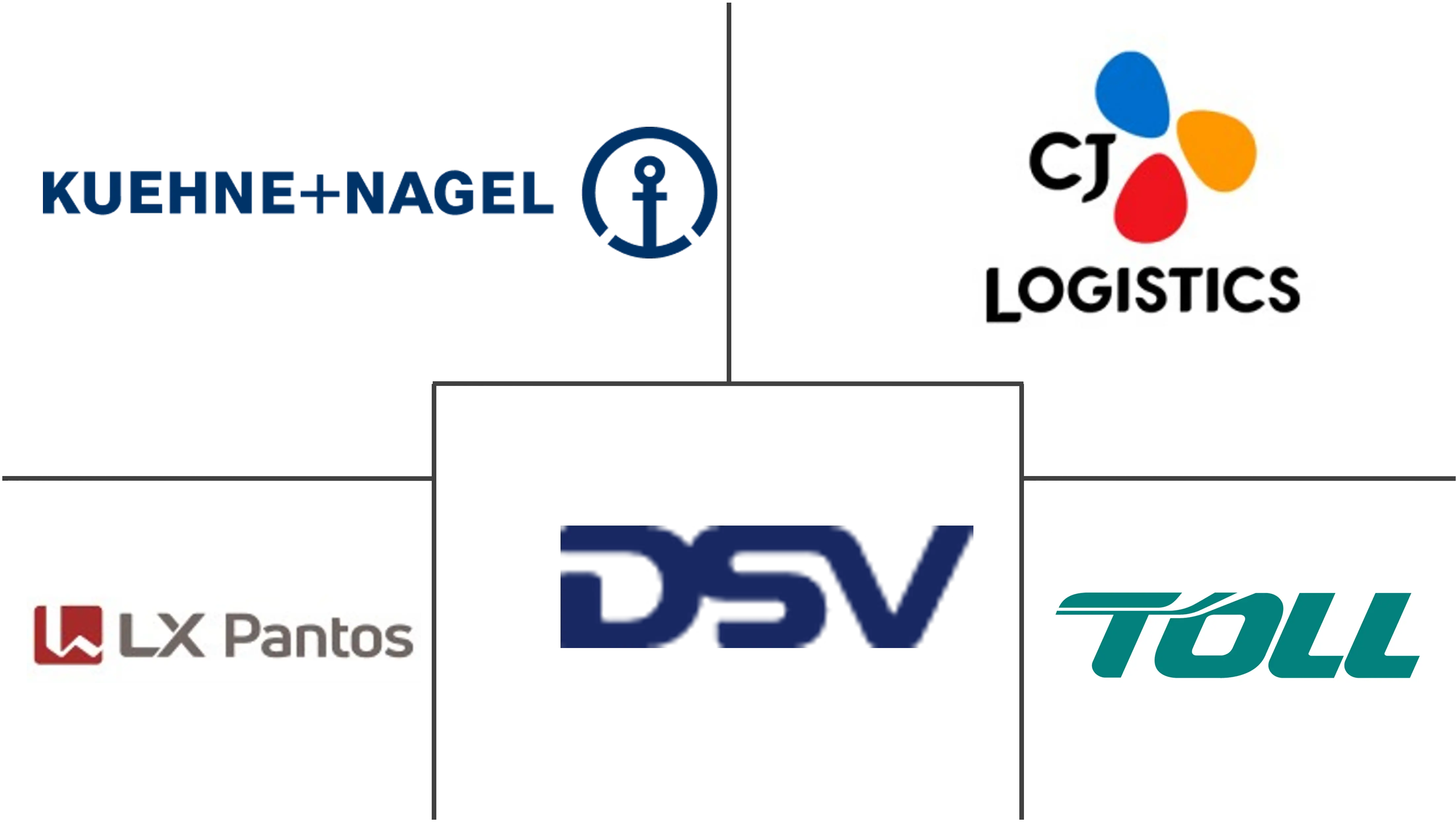Market Size of South Korea Third-Party Logistics (3PL) Industry

| Study Period | 2020-2029 |
| Base Year For Estimation | 2023 |
| Market Size (2024) | USD 28.60 Billion |
| Market Size (2029) | USD 34.89 Billion |
| CAGR (2024 - 2029) | 4.05 % |
| Market Concentration | Low |
Major Players
*Disclaimer: Major Players sorted in no particular order |
South Korea Third Party Logistics (3PL) Market Analysis
The South Korea Third-Party Logistics Market size is estimated at USD 28.60 billion in 2024, and is expected to reach USD 34.89 billion by 2029, growing at a CAGR of 4.05% during the forecast period (2024-2029).
- South Korea is advantageously present between two world-class importers: China to the west and Japan, another Asian economic powerhouse, to the east. It relies on third-party logistics for trade. South Korea is one of the top five 3PL markets in Asia-Pacific. The logistics industry in Korea has rapidly grown over the past ten years, with multinational, major manufacturing and wholesale companies concentrating on the internal and external efficiency and effectiveness of supply chains to reduce logistics costs.
- With the development of e-commerce, the volume of shipments has increased. There is a need to improve the demand for 3PL companies to handle orders continuously. This resulted in competition to deliver goods of good quality, making retailers seek logistics hubs in the Greater Seoul area.
- South Korea boasts a well-developed transportation infrastructure that includes a modern road network, efficient ports, and a robust rail system. Incheon International Airport is a major air cargo hub in the region, contributing significantly to the logistics sector. South Korea's strategic location in Asia makes it a key player in international trade. It is a part of various trade agreements, such as the Korea-US Free Trade Agreement (KORUS FTA) and the Regional Comprehensive Economic Partnership (RCEP), which further boost its logistics activities.
South Korea Third Party Logistics (3PL) Industry Segmentation
Third-party logistics, often known as 3PL, is a system in which a company offers inventory management and delivery services to another company. A 3PL company is frequently used by a company (client) that does not have its own logistics department. In turn, 3PL takes care of some or all of the client's logistics needs.
The South Korean third-party logistics (3PL) market is segmented by service (domestic transportation management, international transportation management, and Value-added Warehousing and Distribution) and by end-user (manufacturing and automotive, oil & gas and chemicals, distributive trade (wholesale and retail trade, including E-commerce), pharma and healthcare, construction, and other end users).
The report offers the market sizes and forecasts for the South Korean third-party logistics (3PL) market in value (USD) for all the above segments.
| By Services | |
| Domestic Transportation Management | |
| International Transportation Management | |
| Value-added Warehousing and Distribution |
| By End-User | |
| Manufacturing and Automotive | |
| Oil & Gas and Chemicals | |
| Distributive Trade (Wholesale and Retail trade including e-commerce) | |
| Pharma & Healthcare | |
| Construction | |
| Other End-Users |
South Korea Third-Party Logistics (3PL) Market Size Summary
The South Korean third-party logistics (3PL) market is a significant player in the Asia-Pacific region, benefiting from the country's strategic location between major economies like China and Japan. The logistics sector has experienced rapid growth, driven by the increasing focus on supply chain efficiency and cost reduction by multinational companies. The rise of e-commerce has further fueled the demand for 3PL services, as retailers seek to enhance their logistics capabilities to meet the growing volume of shipments. South Korea's advanced transportation infrastructure, including modern road networks, efficient ports, and a robust rail system, supports its logistics industry. The country's participation in various trade agreements, such as the Korea-US Free Trade Agreement and the Regional Comprehensive Economic Partnership, bolsters its logistics activities, making it a key hub for international trade.
The expansion of e-commerce and global trade has created substantial opportunities for 3PL providers, particularly in air cargo logistics. South Korea's e-commerce market is one of the largest globally, with a significant portion of retail sales occurring online. The demand for air freight services has increased, driven by the export of high-value products and the need for efficient logistics solutions. The 3PL market in South Korea is characterized by a mix of local and international players, with companies like CJ Logistics and Pantos Logistics leading the competition. The market is also witnessing innovations such as gas station-based logistics hubs, which enhance local delivery services. Investments in logistics infrastructure, both domestically and internationally, are aimed at accommodating rising export volumes and supporting the global expansion of South Korean businesses.
South Korea Third-Party Logistics (3PL) Market Size - Table of Contents
-
1. MARKET INSIGHTS AND DYNAMICS
-
1.1 Market Overview
-
1.2 Market Dynamics
-
1.2.1 Market Drivers
-
1.2.1.1 Global Trade and Export-Oriented Economy boosting the market
-
1.2.1.2 Investment in Robotics and Automation
-
-
1.2.2 Market Restraints
-
1.2.2.1 South Korea's logistics infrastructure, while generally well-developed, can experience congestion in key areas, such as ports and highways
-
1.2.2.2 Like many other countries, South Korea faced issues related to labor shortages in the logistics sector.
-
-
1.2.3 Market Opportunities
-
1.2.3.1 South Korea has a thriving e-commerce sector, with companies like Samsung, LG, and Hyundai expanding their online presence
-
1.2.3.2 South Korea serves as a major hub for global trade, connecting Asia with North America and Europe.
-
-
-
1.3 Industry Attractiveness - Porter's Five Forces Analysis
-
1.3.1 Bargaining Power of Sellers
-
1.3.2 Bargaining Power of Consumers
-
1.3.3 Threat of New Entrants
-
1.3.4 Threat of Substitutes Products and Services
-
1.3.5 Intensity of Competitive Rivalry
-
-
1.4 Value Chain / Supply Chain Analysis
-
1.5 Government Regulations And Initiatives
-
1.6 General Trends In Warehousing Market
-
1.7 Demand From Other Segments, such As Cep, Last Mile Delivery, Cold Chain Logistics etc.
-
1.8 Insights Into The E-commerce Business
-
1.9 Technological Trends
-
1.10 Impact Of COVID-19 on The Market
-
-
2. MARKET SEGMENTATION
-
2.1 By Services
-
2.1.1 Domestic Transportation Management
-
2.1.2 International Transportation Management
-
2.1.3 Value-added Warehousing and Distribution
-
-
2.2 By End-User
-
2.2.1 Manufacturing and Automotive
-
2.2.2 Oil & Gas and Chemicals
-
2.2.3 Distributive Trade (Wholesale and Retail trade including e-commerce)
-
2.2.4 Pharma & Healthcare
-
2.2.5 Construction
-
2.2.6 Other End-Users
-
-
South Korea Third-Party Logistics (3PL) Market Size FAQs
How big is the South Korea Third-Party Logistics Market?
The South Korea Third-Party Logistics Market size is expected to reach USD 28.60 billion in 2024 and grow at a CAGR of 4.05% to reach USD 34.89 billion by 2029.
What is the current South Korea Third-Party Logistics Market size?
In 2024, the South Korea Third-Party Logistics Market size is expected to reach USD 28.60 billion.

